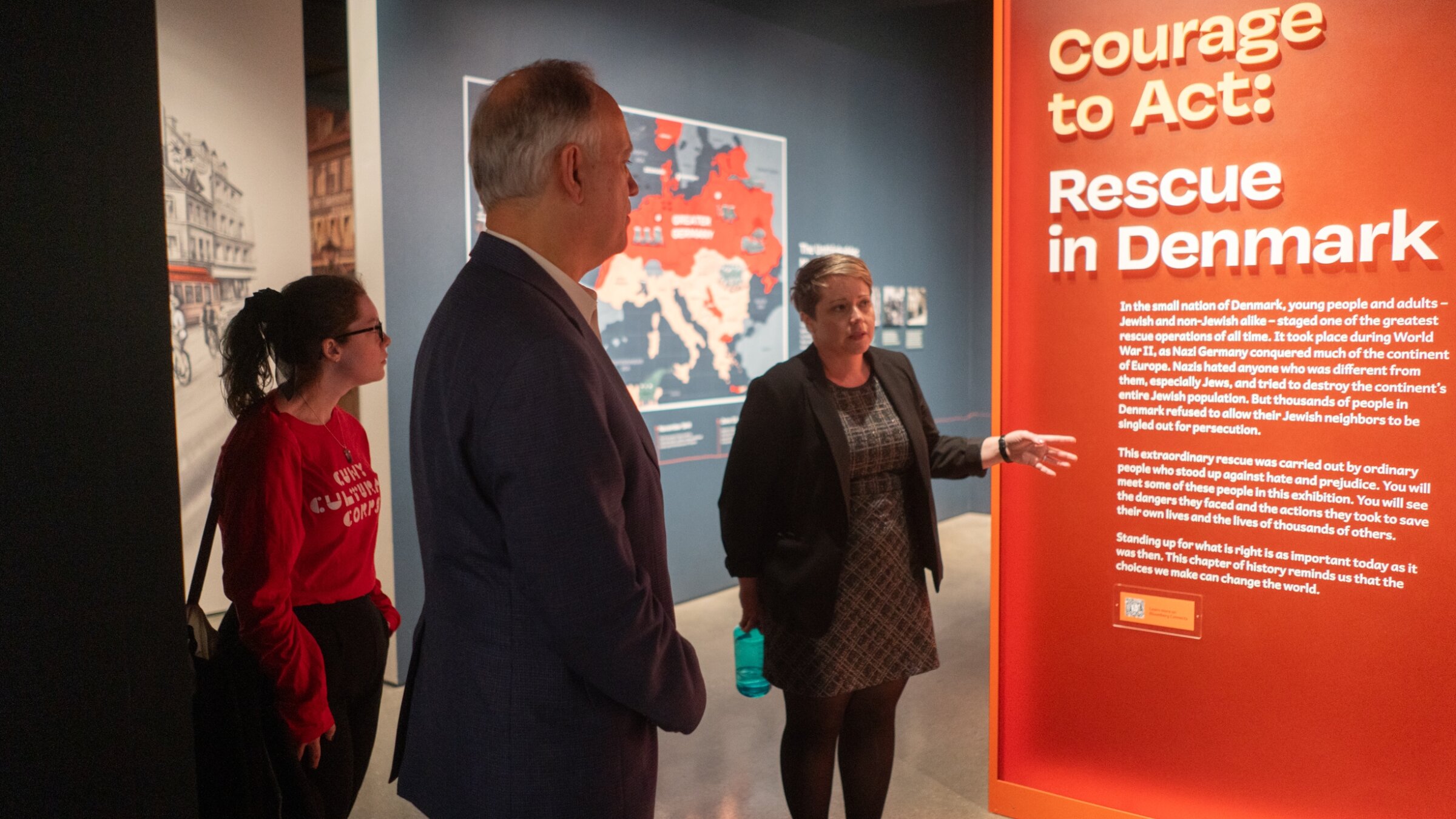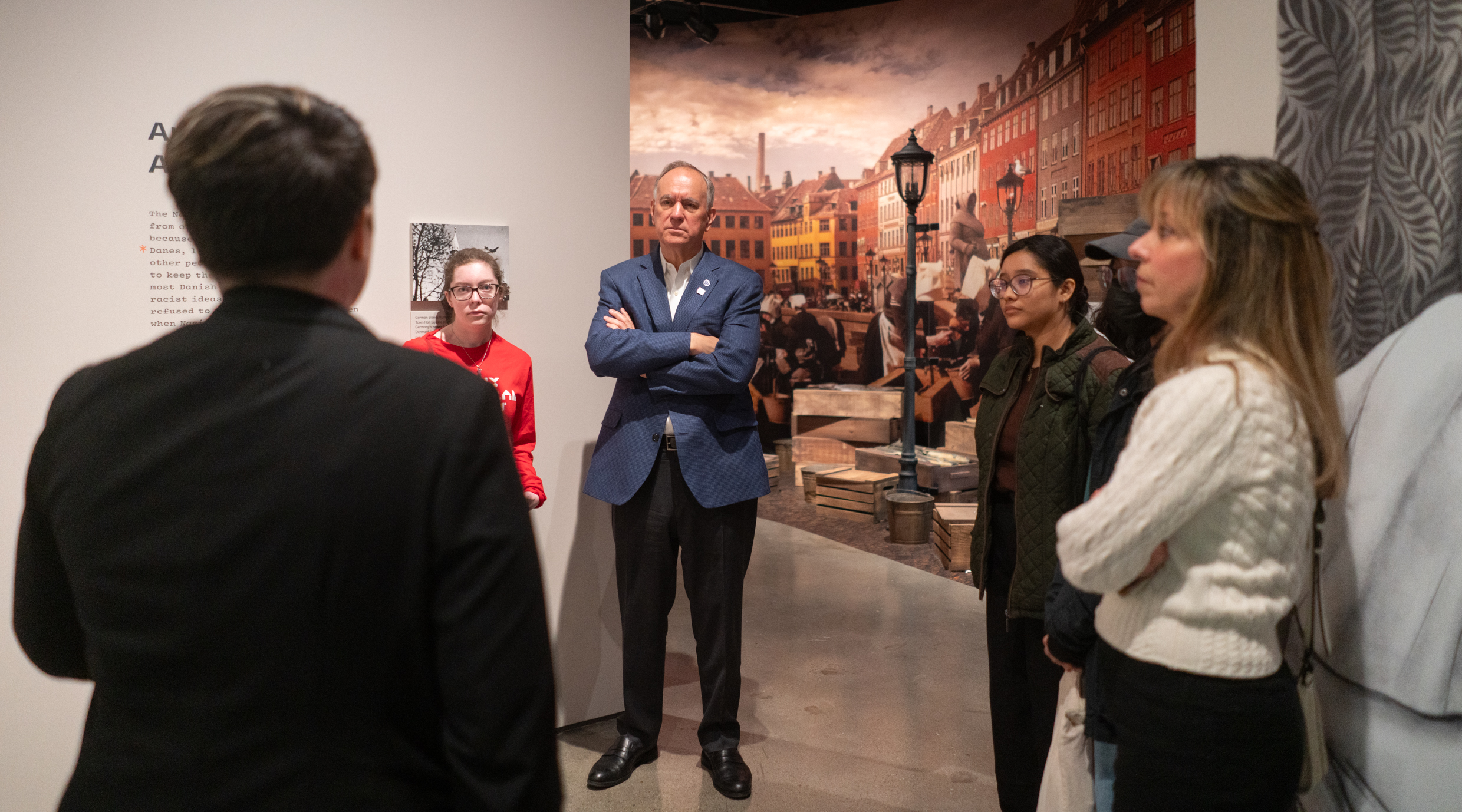The Museum of Jewish Heritage seeks to educate more college-age visitors about the Holocaust, starting with a private tour for CUNY students
“This kind of program is really, really important, always, but I think particularly during these days,” said CUNY Chancellor Félix Matos Rodríguez

CUNY students and CUNY Chancellor Félix V. Matos Rodríguez tour the Museum of Jewish Heritage, March 15, 2024. (Luke Tress)
(New York Jewish Week) – Last week, a group of students from the City University of New York, accompanied by CUNY Chancellor Félix Matos Rodríguez, listened in attentive silence to the story of Denmark’s Jews during the Holocaust and the citizen efforts to evacuate them to Sweden to escape the Nazis.
The private tour of the Museum of Jewish Heritage, part of a partnership with CUNY that started last year, is an early step in the museum’s push to expand its reach to a college-age audience as reports have piled up of antisemitism on campuses around the country. The effort comes several years after officials in New York City made the museum a central part of efforts to inoculate high school students against antisemitism.
“You’re giving them history, you’re giving them the right information, you give them context,” Rodríguez told the New York Jewish Week. “Those are all great, important skills that they need to combat antisemitism, to combat any form of hate, so for us this kind of program is really, really important, always, but I think particularly during these days.”
The museum plans to increase the number of campus visitors, train more college-age educators and expand its outreach to campuses, both physically and virtually. The goal is to educate young people about historical and contemporary antisemitism and combat misinformation.
The museum is in talks with three or four universities in the New York area that are interested in cooperating on Holocaust and antisemitism education, said the museum’s president and CEO, Jack Kliger, who declined to name the specific colleges because the agreements have not been finalized. The museum will hear feedback and conduct research over the summer, and plans to start rolling out the new programs on campuses in the fall.
“There’s just a tremendous amount of misinformation, disinformation and bad information out there, so we see our mission as providing good information to fight bad information,” Kliger said.
The initiative aims to combat antisemitism by addressing historical misconceptions, including by dispelling generalizations about Jews and other groups, and by opening up dialogue “in a positive, mutual and respectful atmosphere,” Kliger said.

An image showing the Museum of Jewish Heritage-A Living Memorial to the Holocaust in New York City. (Museum of Jewish Heritage/John Halpern)
The CUNY program serves as a model for the expansion. Close to 100 students who volunteered for the visit toured the museum throughout the day on March 15. Rodríguez joined a group of around a dozen students for an exhibit called “Courage to Act: Rescue in Denmark,” focused on the Gerda III, a small fishing vessel that rescued around 300 Jews from the Nazis.
CUNY, the nation’s largest public urban university system with 226,000 students, has grappled with allegations of campus antisemitism for years that have only mounted following the outbreak of the Israel-Hamas war. Visits to the museum in Lower Manhattan are part of CUNY’s efforts to combat discrimination against Jews with education. Rodríguez first visited the museum with a group of students last spring.
The museum previously focused its youth education efforts mainly on high school students, with 50,000 to 60,000 high schoolers visiting in the past year. Part of that effort is the museum’s Holocaust Educator School Partnership, a program that trains college interns to teach about the Holocaust in New York high schools. The program started three semesters ago with three trainees and now has 10, most of whom are not Jewish.
By the summer, the museum plans to have trained 25 interns. Kliger estimated that each educator reaches 750 to 1,000 high school students per semester. After the CUNY tour, the students had a luncheon with staffers from the museum to learn about the opportunities.
In addition to the educators, the museum aims to have 25,000 college students visit by the end of 2025, and reach 100,000 students in total on 100 campuses nationally through visits, on-campus activities and virtual programs.
The plans predated Oct. 7, but the Hamas attack and ensuing antisemitism had “accelerated” the need to reach people aged 18-24, Kliger said. The museum believes it is important to get young adults information about the Holocaust because they are at the stage in life when they are “forming themselves and they’re starting out in the world.” Both traditional and social media were spreading inaccurate information that the museum hopes to counter, he said.
The museum has not yet determined how it will approach Israel in its curricula, but “there’s no question we’ll talk about the subject of Zionism and anti-Zionism, where that bridges over into antisemitism,” Kliger said.

CUNY students and CUNY Chancellor Félix V. Matos Rodríguez tour the Museum of Jewish Heritage, March 15, 2024. (Luke Tress)
To that end, earlier this month, the museum released a resource guide for educators that answers common questions they might receive about antisemitism, part of an effort to focus more on contemporary antisemitism as the museum’s mission evolves.
“When we opened the museum in 1997 we thought antisemitism was on the wane and we were talking about lessons of history from the Holocaust, and clearly antisemitism is not on the wane,” Kliger said. Since Oct. 7, educators are getting more questions about “fluidity between what is considered antisemitism and anti-Zionism or what Zionism is,” Kliger said.
During the CUNY tour, Kliger and the chairman of the museum, Bruce Ratner, greeted an enthusiastic Rodríguez and a group of CUNY students as they arrived at the museum. Rodríguez wore a blue square on his lapel, part of a partnership between CUNY and Robert Kraft’s Foundation to Combat Antisemitism. The students all told Kliger it was their first time visiting the museum.
The Courage to Act exhibit focused on Danish civilians rescuing 95% of the country’s Jews during the Holocaust. In addition to expanding to young adults, the museum is looking to have younger students visit, and the exhibit was the museum’s first for visitors as young as 9. The students and Rodríguez were quiet, attentive, and asked a few questions.
“There’s a ton of information, a lot of history that I didn’t even think is out there regarding the Holocaust. I only know what I know from school, the textbooks,” said Aishat Balogun, a senior studying economics at Hunter College. Balogun is in CUNY’s Cultural Corps program that connects students with job opportunities in the city’s arts and culture sectors and learned about the trip through an email.
Balogun, who is not Jewish, said the lessons were important in the current climate because “there has been a lot of hate.”
“It just seems like there’s so much going on, it’s really important to educate yourself and know how to have your own opinions and not just follow society,” she said.
Daniela Urbano, a third-year accounting major at Hunter, said there had been a gap in her education about the Holocaust. She learned about it in elementary school but didn’t recall any lessons in middle or high school. She and her sister had been interested in the subject and watched films on their own, which kept up her curiosity and motivated her to visit the museum. It was her first time visiting any Holocaust museum.
Urbano, who is also not Jewish, said she had been inspired by the Danish resistance.
“So many people stood silent and did not speak or advocate. You really saw how that helped oppress the Jewish people and a lot of other people, minority groups that were targeted by the Nazis,” she said.
“A lot of times, when it’s events like this, you really lose that personal connection when you learn it in a textbook. It feels different from seeing actual survivors talk about it and seeing children that were alive,” she said. “Many of them didn’t come out alive and I think it brings you a sense of how much of a travesty it really was.”
Kliger said he was inspired to work in education by his mother, a survivor from Budapest who had wanted to be a teacher but was blocked from the field due to discrimination. He acknowledged that Holocaust education was not going to eradicate antisemitism but believed the effort has an impact.
“Is there an ideal world where there’s going to be an elimination of antisemitism? I don’t think there will be, but the worst thing in the world would be to stop doing what we’re doing,” he said. “Is this sailing into the wind? Yeah. Should we pull down our sails? No.”
This article originally appeared on JTA.org.
















